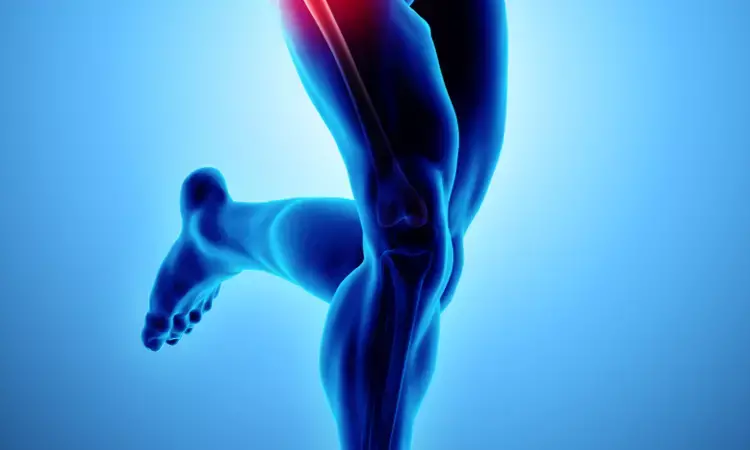- Home
- Medical news & Guidelines
- Anesthesiology
- Cardiology and CTVS
- Critical Care
- Dentistry
- Dermatology
- Diabetes and Endocrinology
- ENT
- Gastroenterology
- Medicine
- Nephrology
- Neurology
- Obstretics-Gynaecology
- Oncology
- Ophthalmology
- Orthopaedics
- Pediatrics-Neonatology
- Psychiatry
- Pulmonology
- Radiology
- Surgery
- Urology
- Laboratory Medicine
- Diet
- Nursing
- Paramedical
- Physiotherapy
- Health news
- Fact Check
- Bone Health Fact Check
- Brain Health Fact Check
- Cancer Related Fact Check
- Child Care Fact Check
- Dental and oral health fact check
- Diabetes and metabolic health fact check
- Diet and Nutrition Fact Check
- Eye and ENT Care Fact Check
- Fitness fact check
- Gut health fact check
- Heart health fact check
- Kidney health fact check
- Medical education fact check
- Men's health fact check
- Respiratory fact check
- Skin and hair care fact check
- Vaccine and Immunization fact check
- Women's health fact check
- AYUSH
- State News
- Andaman and Nicobar Islands
- Andhra Pradesh
- Arunachal Pradesh
- Assam
- Bihar
- Chandigarh
- Chattisgarh
- Dadra and Nagar Haveli
- Daman and Diu
- Delhi
- Goa
- Gujarat
- Haryana
- Himachal Pradesh
- Jammu & Kashmir
- Jharkhand
- Karnataka
- Kerala
- Ladakh
- Lakshadweep
- Madhya Pradesh
- Maharashtra
- Manipur
- Meghalaya
- Mizoram
- Nagaland
- Odisha
- Puducherry
- Punjab
- Rajasthan
- Sikkim
- Tamil Nadu
- Telangana
- Tripura
- Uttar Pradesh
- Uttrakhand
- West Bengal
- Medical Education
- Industry
Ultrasound Emerges as Reliable Alternative to MRI for Assessing Hip Joint Capsule Thickness, claims study

The hip joint capsule plays a crucial role in hip function and stability, with its thickness being a significant factor in various medical conditions, surgical outcomes, and rehabilitation strategies. While magnetic resonance imaging (MRI) has been the primary tool for measuring hip joint capsule thickness, a recent study explores the viability of ultrasound as an alternative method. This study was published in BMC Musculoskeletal Disorders by Gao G. and colleagues.
This research aims to evaluate the consistency between ultrasound and MRI measurements, shedding light on the potential clinical utility of ultrasound in assessing hip joint capsule thickness. A retrospective analysis included 307 patients who underwent both hip joint MRI and ultrasound imaging within a three-month timeframe. The study examined the consistency of measurements between the two methods and explored correlations between hip joint capsule thickness and other hip parameters, such as the alpha angle, lateral center-edge angle, acetabular anteversion angle, and femoral anteversion angle.
Key Findings:
• Consistency of Measurements: Both MRI and ultrasound measurements of hip joint capsule thickness showed good agreement, with respective averages of 5.0 ± 1.2 mm and 5.0 ± 1.5 mm. Bland-Altman analysis revealed strong consistency (p-value = 0.708).
• Statistical Comparison: The paired t-test indicated no significant statistical difference between ultrasound and MRI measurements, affirming the reliability of ultrasound in assessing hip joint capsule thickness.
• Correlation with Acetabular Anteversion Angle: A noteworthy correlation was found between acetabular anteversion angle and hip joint capsule thickness measured by ultrasound, suggesting a potential link between these factors.
The study's findings propose that ultrasound can be a dependable alternative to MRI for measuring hip joint capsule thickness in clinical practice. The strong consistency observed between the two methods emphasizes the potential of incorporating ultrasound as a routine assessment tool. Additionally, the correlation between acetabular anteversion angle and hip joint capsule thickness opens avenues for further research in understanding the intricate relationships within the hip joint.
Reference:
Gao, G., Fang, H., Zhou, K., Mo, Z., Liu, J., Meng, L., Wang, J., & Xu, Y. (2024). Ultrasound had high accuracy in measuring hip joint capsule thickness. BMC Musculoskeletal Disorders,2024;25(1):101. https://doi.org/10.1186/s12891-024-07228-0
Dr Riya Dave has completed dentistry from Gujarat University in 2022. She is a dentist and accomplished medical and scientific writer known for her commitment to bridging the gap between clinical expertise and accessible healthcare information. She has been actively involved in writing blogs related to health and wellness.
Dr Kamal Kant Kohli-MBBS, DTCD- a chest specialist with more than 30 years of practice and a flair for writing clinical articles, Dr Kamal Kant Kohli joined Medical Dialogues as a Chief Editor of Medical News. Besides writing articles, as an editor, he proofreads and verifies all the medical content published on Medical Dialogues including those coming from journals, studies,medical conferences,guidelines etc. Email: drkohli@medicaldialogues.in. Contact no. 011-43720751


